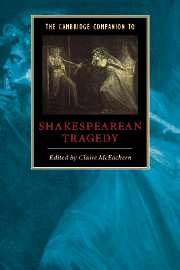Book contents
- Frontmatter
- 1 What is a Shakespearean tragedy?
- 2 The language of tragedy
- 3 Tragedy in Shakespeare’s career
- 4 Shakespearean tragedy printed and performed
- 5 Religion and Shakespearean tragedy
- 6 Tragedy and political authority
- 7 Gender and family
- 8 The tragic subject and its passions
- 9 Tragedies of revenge and ambition
- 10 Shakespeare’s tragedies of love
- 11 Shakespeare’s classical tragedies
- 12 The critical reception of Shakespeare’s tragedies
- 13 Antony and Cleopatra in the theatre
- Select bibliography
- Index
- Series List
3 - Tragedy in Shakespeare’s career
Published online by Cambridge University Press: 28 May 2006
- Frontmatter
- 1 What is a Shakespearean tragedy?
- 2 The language of tragedy
- 3 Tragedy in Shakespeare’s career
- 4 Shakespearean tragedy printed and performed
- 5 Religion and Shakespearean tragedy
- 6 Tragedy and political authority
- 7 Gender and family
- 8 The tragic subject and its passions
- 9 Tragedies of revenge and ambition
- 10 Shakespeare’s tragedies of love
- 11 Shakespeare’s classical tragedies
- 12 The critical reception of Shakespeare’s tragedies
- 13 Antony and Cleopatra in the theatre
- Select bibliography
- Index
- Series List
Summary
In one sense, Shakespeare wrote tragedies throughout his career. To be sure, among the plays classified as tragedies in the great Folio edition of 1623, only Titus Andronicus (c. 1589-92) and Romeo and Juliet (1594-6) were written before 1599. Yet Shakespeare certainly pursued tragic themes and consequences in his early historical plays. The title page of The First Part of the Contention betwixt the Two Famous Houses of York and Lancaster, published in 1594 as a somewhat shortened version of what was to appear in the 1623 Folio as The Second Part of Henry the Sixth, announces among its subjects 'the death of the good Duke Humphrey', the 'banishment and death of the Duke of Suffolk', and 'the tragical end of the proud Cardinal of Winchester'. The True Tragedy of Richard Duke of York, and the Death of Good King Henry the Sixth, published in 1595 as a version of what was to appear in the 1623 Folio as The Third Part of Henry the Sixth, describes itself as a tragedy in that quarto title. So does The Tragedy of Richard III, registered and published in 1597 after having been written in about 1592–4. The Life and Death of King John (written in about 1594–6 and first published in the 1623 Folio) and The Tragedy of Richard the Second (registered and published in 1597) are similarly characterized as tragedies on their title pages, at least (in the case of King John) by the implications of tragedy in the King’s ‘death’.
- Type
- Chapter
- Information
- The Cambridge Companion to Shakespearean Tragedy , pp. 50 - 68Publisher: Cambridge University PressPrint publication year: 2003



